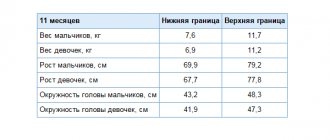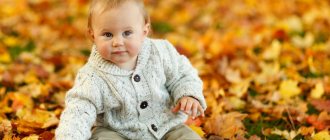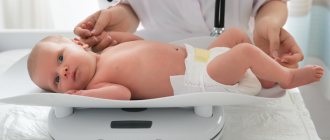It has long been known that a person’s well-being depends on the weather. And although “nature has no bad weather,” most kids are sensitive to its changes. Recently, doctors have begun studying how our body reacts to weather changes, because these reactions complicate the course of many diseases in children (as well as in adults). This is how a new direction in pediatrics emerged—children’s meteorological pathology, or kerosopathology. Now, when prescribing treatment, specialists have the opportunity to take into account the baby’s sensitivity to weather changes.
And outside the window it’s either rain or snow: weather sensitivity in children
Experts call a reaction to weather changes the restructuring of the biological systems of the human body in response to changes in atmospheric factors: pressure, temperature, humidity. This restructuring may be accompanied by disturbances in behavior, well-being, and a decrease in coping mechanisms (adaptation). Normally, a healthy baby’s body should adapt to changes in the world around him quickly and easily, without causing any particular inconvenience. The exception is newborns: they do not have ready protection from the external environment, but only an innate ability to gradually adapt to natural light, low and high temperatures, and air humidity. At the same time, the baby gradually acquires the skills of “taming” the effects of electromagnetic and infrasonic vibrations and changes in atmospheric pressure, as the body grows up and hardens (although familiarity with these phenomena occurs even before birth, that is, in utero).
Children are considered weather-sensitive, whose bodies, in response to atmospheric changes, produce painful reactions: children quickly get tired, are capricious, have difficulty falling asleep, sleep poorly, and their chronic diseases become worse. Sensitivity to weather changes is not a permanent feature of our body. It intensifies depending on how sick the baby is. In addition, at a certain age, children react more acutely to the weather. They are especially vulnerable during critical periods of immune development:
- up to 6 months;
- during the second year of life;
- at 6-7 years old;
- at 12-15 years old.
The body’s ability to respond correctly to weather changes is weakened by overwork, emotional stress, and also due to illness, when the work of the central regulatory organs is disrupted (primarily the autonomic nervous system, which is responsible for the constancy of the internal environment of the baby’s body, regardless of external conditions) . The results of studies conducted by pediatricians show that children suffering from chronic or prolonged illnesses are very sensitive to weather changes (see table).
Meteor dependence in a baby - what to do?
Children are also susceptible to weather dependence, but there are symptoms that are characteristic only of children. If you notice that changes in the weather are affecting the child’s condition, you need to help him.
Weather sensitivity manifests itself most acutely at a young age - the younger the child, the more sensitive he is, because the adaptive mechanisms are not yet sufficiently developed. And if the little ones also have vegetative-vascular dystonia, then changes in the weather will become torture.
Vegetative-vascular dystonia is accompanied by some symptoms: Cold extremities; Marble skin color; Pallor; Headache; Increased fatigue, etc.
Also, children with pyelonephritis and tonsillitis react more acutely to weather changes. Studies have shown that changes in the weather worsen the condition of sick babies by 30%, and with dermatitis, gastritis and asthma - by 50%.
As we mentioned, children have characteristic symptoms that do not appear in adults. This is a perverted reaction to the weather - nervous excitability, hysteria, short temper, etc. However, these symptoms are more common in children with developmental problems associated with birth trauma, brain dysfunction, central nervous system disorders, etc. These babies require special care. And although the child is considered healthy, the nervous system is sensitive and vulnerable, this is worth taking into account.
And the symptoms, in general, are the same as in adults: Drowsiness; Fatigue; Headache; Aches in the joints; Poor appetite, etc.
Meteor dependence manifests itself when the weather changes: A decrease or increase in pressure by 1-1.5 mm in 3 hours; Warming; Passage of an atmospheric front (rain, thunderstorm, wind); Magnetic storms; Flashes in the sun.
If you know that your baby feels a change in pressure or weather, then during such periods you need to be nearby and monitor his well-being. At the same time, there is no need to change the regime and treat the baby as if he were sick. He should eat on time, and it is also advisable to take a nap during the day - it helps fight weather dependence.
To ensure that such dependence is accompanied by minimal symptoms, try to harden it from an early age - exercise, contrast showers, swimming and sports. Such training is a great way to combat dystonia.
If a child becomes hyperactive when the weather changes, then it is necessary to give him a decoction of St. John's wort, motherwort, mint, valerian, and sage. Add a teaspoon of each herb and pour two cups of boiling water. Leave in a thermos for about half an hour and give 3 tbsp. l. in between meals.
And don’t scold your child because he can’t complete the task, is naughty, screams, cries, etc. It's weather sensitivity that's to blame, not your child.
Childhood illnesses and changes
| Organ systems | Diseases | Frequency of reactions of sick children to weather changes |
| Cardiovascular | Vegetodystonia | 80% |
| Respiratory | Pneumonia Bronchial asthma | 34% 53% |
| Digestive | Chronic gastritis Pyelonephritis | 42% 32% |
| Hematopoiesis | Hemophilia | 58% |
| Leather | Children's eczema Neurodermatitis | 42% 39% |
Doctors distinguish 4 types of weather. They rely on them when studying the impact of weather conditions on children. Types I and II
- these are favorable conditions for the human body when processes in the atmosphere go smoothly.
Types III and IV
are unfavorable conditions, they are accompanied by fluctuations in temperature, atmospheric pressure, air speed and abnormal weather phenomena (thunderstorm, blizzard, geomagnetic storm). People with increased meteosensitivity react to types III and IV weather, which is manifested by a so-called vegetative crisis, which is accompanied by numerous complaints of poor health and exacerbation of current and chronic diseases. A classic example of unfavorable weather is the development of a cyclone over the European part of Russia on February 5, 1999, when the atmospheric pressure in Moscow dropped to a critical point - 711 mm Hg. pillar Almost everyone, young and old, felt external oppression, and experts noted the exacerbation of chronic diseases and the rise of the influenza epidemic. Another example: sunny weather is associated with the displacement of a cyclone by an anticyclone and an increase in atmospheric pressure. Against the background of these events, vertical air currents are activated, which leads to an increase in the concentration of harmful substances, primarily allergens, at the surface of the earth. This is the true reason for the increase in allergic reactions among young Muscovites at the beginning of October this year.
And it’s time to sleep, but I can’t fall asleep...
To understand how the weather affects the baby’s body, the doctor must collect a lot of data: whether the child tolerates climate and weather changes well, whether his behavior changes due to changes in the atmosphere, how the disease develops if the baby is sick. After analyzing these data, the doctor determines the weather sensitivity index and makes a conclusion whether the baby’s body’s reactions correspond to the norm. In some cases, painful reactions to weather changes may appear earlier or later than the change actually occurs. In the first case, it is called a signal signal, when the body detects electromagnetic and infrasonic vibrations in the atmosphere before a visible change in the weather. And in the second - subsequent, it means that it takes a certain time for the development of a response.
There are two types of meteotropic reactions in children:
- First type.
The influence of weather leads to the fact that the baby gets sick or his chronic diseases worsen. - Second type.
In response to weather changes, the baby becomes whiny, sleeps poorly, gets tired quickly, and complains of headaches. In the first case, we can talk about a pronounced form of meteorological reactions, and in the second - about a hidden one.
Understanding how babies' bodies react to weather changes helps doctors anticipate possible exacerbations of diseases. Based on the weather forecast and the child's reactions, treatment can be prescribed or possible painful exacerbations can be prevented. For example, we know that most infants, especially if they are bottle-fed, react to sudden weather changes with colic and bloating. Therefore, shortly before the weather changes, the pediatrician may prescribe a medicine that will prevent discomfort. Children with chronic diseases, such as bronchial asthma, need to be prescribed or intensified treatment on days of unfavorable weather.
Seasonal changes
About half of children react to seasonal weather changes with whims, causeless tantrums, overexcitement and headaches.
A healthy body should not react to weather changes. However, an immature nervous system and disruptions in the functioning of the endocrine system in children lead to the development of meteotropic reactions. Children born after a difficult pregnancy, caesarean section, as a result of a difficult birth or premature babies are especially sensitive to bad weather.
Of course, nature does not have bad weather. But what should we, parents, do if the child reacts sharply to her slightest fluctuations?!
And only you are missing a little...
If the deterioration in the baby’s health is not associated with any external reasons (viral infections, poor diet), this means that it can be caused by a change in weather. The care of his parents, or rather, their attentive attitude to his condition, will help protect him from the adverse effects of the weather. Warm clothes and heaters will protect the child from cold and moisture, a Panama hat and sunglasses from the sun's rays, and reasonable hardening from changes in atmospheric pressure, electromagnetic and infrasonic vibrations. Constant walks, clothing according to the season, air and water procedures (preferably contrasting ones) train the body, allowing it to more easily adapt to weather conditions of types III and IV. To strengthen its protective powers, scientists suggest using special pressure settings with adjustable pressure levels. In addition, children will benefit from vitamin-mineral complexes that contain the required minimum of nutrients (children under 2 years of age receive them from baby food).
For children sensitive to weather changes, doctors choose one of three types of meteorological prevention depending on the duration of its implementation: one-time, current and seasonal. Such treatment should be selected individually, taking into account the characteristics of each child’s body. In addition to the necessary medications, children are prescribed massage, therapeutic exercise, physiotherapeutic procedures, reflexology, and homeopathic remedies.
Half a year of bad weather
Experts have noticed that weather changes have the greatest impact on newborns and infants up to one year old, with premature babies and those born by caesarean section having the hardest time. Little ones have difficulty adapting to life outside the safe, warm and comfortable water environment, and then there is our unstable climate (about every fifth day meteorologists call it unfavorable for one reason or another). So the kids suffer, and along with them their families.
What affects children?
- Air temperature
What is important is not the heat or frost per se, but the sharp temperature difference during the day or between them. A large difference between day and night temperatures or sudden changes in weather have an adverse effect on weather-sensitive people - both children and adults.
- Atmosphere pressure
The average, comfortable value for humans is 760 mm Hg. But in our latitudes such pressure does not happen every day. The permeability of blood vessels in children is higher than in adults. Therefore, changes in atmospheric pressure greatly affect the pressure in the children's circulatory system. And this is fraught with poor health: headaches, dizziness, weakness.
- Air humidity
This factor is also important for our condition. Excessive sweating with a sharp drop in humidity can lead to thickening of the blood and, as a result, to poor circulation and changes in heart rate. A sharp increase in humidity is no better: in hot weather it can lead to overheating and heat stroke, and in cold weather it can lead to hypothermia.
- Wind speed and strength
The wind affects the still fragile nervous system of children. On cold and humid, windy days, there is an increase in excitability, anxiety, and sleep disturbances. Doctors call this condition meteoneurosis.
- Magnetic storms
We, adults, relatively strong and healthy people, often treat the term “magnetic storms” with irony. Like, horror stories for grandmothers. However, scientists are confident that magnetic storms have a very strong effect on the nervous system of children: they cause long-term stress (from 3 to 6 hours). Irritability, imbalance and whims of children on such days are not fiction. Moreover, the consequences of magnetic storms can affect the babies for several days.
Which children are the most weather dependent?
The answer to this question is simple – children are not the healthiest. If you notice that weather changes are affecting your baby too much, be sure to have your child examined. After all, significant weather sensitivity is often associated with some diseases that we may not even be aware of.
What most often worries weather-sensitive children?
- Headache
- Exacerbation of chronic diseases











